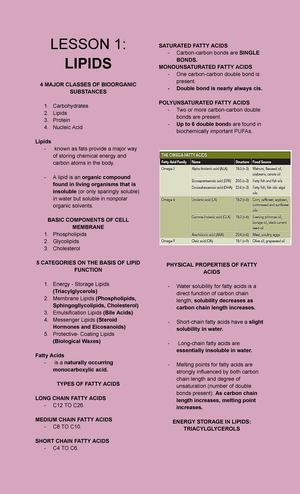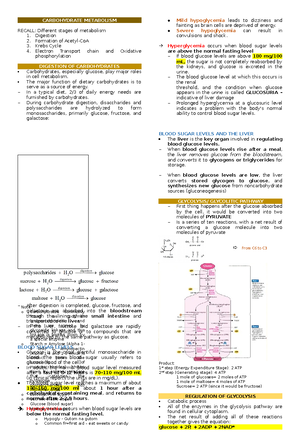- Information
- AI Chat
Was this document helpful?
Lipid- Metabolism
Course: BIOCHEMISTRY (CHM3)
365 Documents
Students shared 365 documents in this course
University: Our Lady of Fatima University
Was this document helpful?

LIPID METABOLISM
- Metabolic oxidation of lipids releases large quantities of energy
through production of acetyl-CoA, NADH and FADH2
Fatty Acids- chief source of energy in the catabolism of lipid
Triacylglycerols and phosphoacylglycerols- have fatty acids
- Bond between the fatty acid and the rest of the molecule can
be hydrolyzed, by enzymes—lipases, and phospholipases
Epinephrine- release of fatty acids from triacylglycerols in adipocytes
Caffeine- mimics epinephrine
•A hormone binds to a receptor on the plasma membrane of the
adipocyte
•This hormone binding activates adenylate cyclase which leads to
production of active protein kinase A (cAMP-dependent protein
kinase).
•Protein kinase phosphorylates triacylglycerol lipase, which cleaves
the fatty acids from the glycerol backbone.
SITES OF VARIOUS ASPECTS OF FATTY ACID METABOLISM
1. Mitochondria- catabolism by B-oxidation, chain lengthening
2. ER- chain lengthening, introduction of double bonds
3. Nucleus
4. Cell membrane
5. Cytosol- anabolism, formation of acyl-CoA
FORMATION OF ACYL-COA
•Fatty-acid oxidation begins with activation of the molecule.
•Thioester bond is formed between the carboxyl group of the fatty
acid and the thiol group of coenzyme A (CoA-SH).
•Activated form of the fatty acid is an acyl-CoA, the exact nature of
which depends on the nature of the fatty acid itself.
•All acyl-CoA molecules are thioesters, since the fatty acid is esterified
to the thiol group of CoA.
•Enzyme that catalyzes formation of the ester bond, an acyl-CoA
synthetase, requires ATP for its action.
•An acyl adenylate intermediate is formed. The acyl group is then
transferred to CoA-SH. ATP is converted to AMP and PPi , rather than
to ADP and Pi . The PPi is hydrolyzed to two Pi ; the hydrolysis of two
high-energy phosphate bonds provides energy for the activation of the
fatty acid and is equivalent to the use of two ATP.
•The formation of the acyl-CoA is endergonic, without the energy
provided by the hydrolysis of the two high-energy bonds. Note also
that the hydrolysis of ATP to AMP and two Pi represents an increase in
entropy
THE ROLE OF CARNITINE IN THE TRANSFER OF ACYL GROUPS TO THE
MITOCHONDRIAL MATRIX
•The acyl-CoA can cross the outer mitochondrial membrane but not
the inner membrane. In the intermembrane space, the acyl group is
transferred to carnitine by transesterification; this reaction is catalyzed
by the enzyme carnitine acyltransferase, which is located in the inner
membrane.
•Acyl-carnitine, a compound that can cross the inner mitochondrial
membrane is formed.
•The enzyme that has a specificity for acyl groups between 14 and 18
carbons long and is often called carnitine palmitoyltransferase (CPT-I).
•The acyl-carnitine passes through the inner membrane via a specific
carnitine/acyl-carnitine transporter called carnitine translocase.
•Once in the matrix, the acyl group is transferred from carnitine to
mitochondrial CoA-SH by another transesterification reaction,
involving a second carnitine palmitoyltransferase (CPT-II) located on
the inner face of the membrane.
HOW DOES OXIDATION OF FATTY ACIDS TAKE PLACE?
•In the matrix, a repeated sequence of reactions successively cleaves
two-carbon units from the fatty acid, starting from the carboxyl end.
•This process is called β-oxidation, since the oxidative cleavage takes
place at the β-carbon of the acyl group esterified to CoA.
- The β-carbon of the original fatty acid becomes the carboxyl
carbon in the next stage of degradation. The whole cycle
requires four reactions.
FATTY ACID OXIDATION
1.The acyl-CoA is oxidized to an α, β unsaturated acyl-CoA (also called
a βenoyl-CoA). The product has the trans arrangement at the double
bond. This reaction is catalyzed by an FAD-dependent acyl-CoA
dehydrogenase.
2.The unsaturated acyl-CoA is hydrated to produce a β-hydroxyacyl-
CoA. This reaction is catalyzed by the enzyme enoyl-CoA hydratase.
3.A second oxidation reaction is catalyzed by β-hydroxyacyl-CoA
dehydrogenase, an NAD+-dependent enzyme. The product is a β-
ketoacyl-CoA.
4.The enzyme thiolase catalyzes the cleavage of the β-ketoacyl-CoA; a
molecule of CoA is required for the reaction.
5.The products are acetyl-CoA and an acyl-CoA that is two carbons
shorter than the original molecule that entered the β-oxidation cycle.
6.The CoA is needed in this reaction to form the new thioester bond in
the smaller acyl-CoA molecule. This smaller molecule then undergoes
another round of the β-oxidation cycle.
CHOLESTEROL BIOSYNTHESIS
•The ultimate precursor of all the carbon atoms in cholesterol and in
the other steroids that are derived from cholesterol is the acetyl group
of acetyl-CoA
BIOSYNTHESIS OF MEVALONATE
•The production of mevalonate from hydroxymethylglutaryl-CoA is
catalyzed by hydroxymethylglutaryl-CoA reductase
•The carbonyl group, the one bonded to CoA-SH, is reduced to a
hydroxyl group – CoA-SH is released.
- This step is inhibited by high levels of cholesterol and is the
major control point of cholesterol synthesis.
HMG-COA REDUCTASE INHIBITORS
•Drugs such as lovastatin are inhibitors of hydroxymethylglutaryl-CoA
reductase and are widely prescribed to lower blood cholesterol levels.










